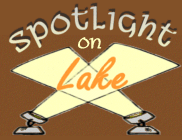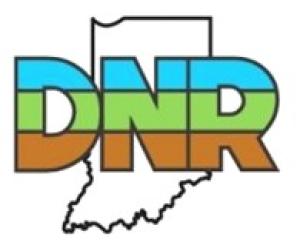
Busseron Creek to offer prime spot for outdoor recreation and support for national security interests
The Indiana Department of Natural Resources (DNR) recently closed on the acquisition of 3,950 acres of forests, marshland, and upland habitat in Sullivan County that will be known as Busseron Creek Fish & Wildlife Area (FWA).
The permanently conserved land, once part of the former Minnehaha FWA, was acquired through a collaboration with the Conservation Law Center and its Southern Indiana Sentinel Landscape initiative, and The Conservation Fund. Additional project support came from The Nature Conservancy in Indiana.

“Powered by partnerships, the permanent protection of Busseron Creek Fish & Wildlife Area is a win for conservation and a win for Indiana, returning nearly 4,000 acres of land for all Hoosiers to enjoy,” said Dan Bortner, DNR director. “Whether you enjoy hunting, fishing, or viewing Indiana’s magnificent wildlife, we look forward to welcoming Hoosiers and visitors alike to Busseron Creek when the property opens to the public in 2025.”
More information about Busseron Creek FWA and the land’s history is available, and video can be accessed on the DNR YouTube channel.

Ice fishing safely
Before you go ice fishing this season, be sure to review these top safety tips:
- Know the body of water that you're going to fish. Be mindful of creeks or springs along lakes and ponds, which could make ice unsafe. Beaver lodges will often have weak ice around them.
- Stay off of moving water. Indiana doesn't have cold enough winters to safely freeze our rivers and streams.
- Never walk on less than 4 inches of ice. Know that even 4 inches of ice late in the season may not be safe to walk on, as ice can be waterlogged or honeycombed at these times.
- ATVs need 8 to 12 inches of ice. Small vehicles need 12 to 15 inches of ice. Trucks need 15 inches or more of ice.
- Snow insulates ice. This can cause weak spots and slow the freezing process.
- Dress appropriately for the day. Wear a Coast Guard-approved personal flotation device, brightly colored clothes, ice creepers, wool clothing, a hat, and sunglasses.
- Never fish alone. Tell someone where you are going and when you plan to return.
Find lakes and depth maps on the Where to Fish Interactive Map.

A new year to hunt and trap
Have you tried hunting small game and furbearers? January can be the perfect time to go outdoors and harvest species such as beaver, raccoon, opossum, squirrel, and rabbit. Find hunting season dates in our Hunting & Trapping Guide, and find out what you can cook with your harvest by watching DNR’s recipe videos on YouTube.
Natural Resources Commission seeks input on proposed bobcat trapping rule changes
![]() Indiana’s Natural Resources Commission (NRC) has opened its second public comment period for proposed changes to allow the limited, regulated trapping of bobcats in designated counties. In March, the Indiana General Assembly passed legislation (Senate Enrolled Act 241) directing the Indiana Department of Natural Resources (DNR), by July of 2025, to have rules in place for bobcat harvest.
Indiana’s Natural Resources Commission (NRC) has opened its second public comment period for proposed changes to allow the limited, regulated trapping of bobcats in designated counties. In March, the Indiana General Assembly passed legislation (Senate Enrolled Act 241) directing the Indiana Department of Natural Resources (DNR), by July of 2025, to have rules in place for bobcat harvest.
Public comments can be submitted at IN.gov/nrc/rules/rulemaking-docket/ using the “Submit Comments Here” link under the Bobcat Amendments Proposed Rule. Comments can also be mailed to the NRC. The deadline for public comments is Jan. 16, 2025. The public hearing will be held on Jan. 16, 2025, between 5:30-8 p.m. ET at the Johnson County Fairgrounds (Scott Hall); 250 Fairgrounds Street; Franklin, IN 46131. Interested members of the public can attend in person or online anytime during that timeframe. The public hearing will also be webcast live at IN.gov/nrc/rules/rulemaking-docket during the time of the public hearing, and viewers will be able to comment during the webcast.
Please note that comments received during the first comment period will be included with comments received during this second comment period. Multiple comments given by the same person will only be counted as one comment by that person.
For more information on the proposed rule changes and submitting comments, visit on.IN.gov/dfw-rule-changes.
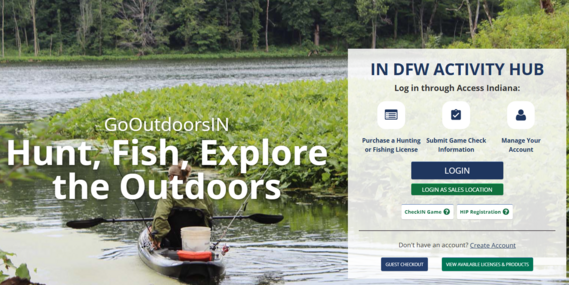
New Activity Hub launches
The Indiana DNR Division of Fish & Wildlife launched a new license system, the Activity Hub, on Dec. 11. This replaced the current system and includes core functionalities, such as license sales, game check-in, HIP registration, donations, and gift certificates. In future rollouts, the system will support property check-in, volunteer management, event registration, reserved hunts, and a smartphone application. Improved functions and new features of the Hub include options for the auto-renewal of licenses and purchases of durable license cards, as well as enhanced support for high-volume traffic.
All customers must log in through Access Indiana. Those with existing Access Indiana accounts will be able to log in without disruption. When logging into the Hub for the first time, customers will need to look themselves up in the system and verify their personal information. On their next login, they will be taken directly to their account page.
Customers who have questions regarding their accounts should contact the DNR Customer Service Center at 317-232-4200, 877-463-6367, or INHuntFish@dnr.IN.gov.
![]() Opt in to the Deer Management Survey
Opt in to the Deer Management Survey
Each year, the Indiana DNR invites the public to provide feedback on the management of white-tailed deer via the Deer Management Survey. The electronic survey gathers opinions of deer management at both the county and state level, covering deer population management, trends in deer populations, and other relevant topics such as chronic wasting disease (CWD), land access, and equipment types permitted for hunting.
Anyone can sign up to receive the survey by visiting our Deer Management Survey webpage. If you have previously filled out the survey, you will automatically receive one in future years.
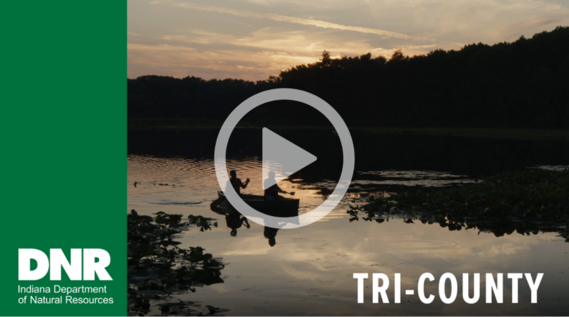
Visit Tri-County Fish & Wildlife Area and Pisgah Marsh Nature Preserve
Tri-County Fish & Wildlife Area (FWA) in Syracuse provides unique upland forest and wetland habitat that supports healthy wildlife populations and diverse recreation opportunities. Within Tri-County FWA lies Pisgah Marsh Nature Preserve, which boasts a quarter-mile boardwalk that allows guests a unique glimpse into the marsh without disrupting the habitat.
From fishing to volunteering, wildlife watching to waterfowl hunting, Tri-County FWA and Pisgah Marsh Nature Preserve have something for all outdoor enthusiasts. Plan your visit today.

Volunteers from Lippert Component’s Marine Manufacturing Division participating in DFW’s Adopt-A-Ramp volunteer opportunity at the Frank Zappia public access site on the St. Joseph River.
Volunteer with the DNR in 2025
Martin Luther King Jr. Day on January 20 is recognized as a National Day of Service. Rather than taking the day off, spend your day making a positive impact in your community. Whether you’re interested in an ongoing volunteer role, short-term project, or one-time event for yourself or your group, consider joining the Division of Fish & Wildlife’s volunteer team. Create a volunteer profile and register for opportunities so that you can share your passion for outdoor recreation and wildlife conservation with your community.

January is a good month to spot wildlife tracks
Snow blanketing the ground creates a canvas for spotting wildlife tracks. Here are some tips for exploring snow-covered trails or your own backyard to reveal a whole world of activity you might otherwise miss.
Tips and Tricks:
- Look near water sources, tree lines, or feeding spots where animals are more likely to gather.
-
Find an Indiana wildlife track identification book or website to help you identify the animal you are tracking. Some animal tracks are more common to spot in Indiana, and here are some examples:
- Deer: Heart-shaped hooves, often in pairs.
- Rabits: A hopping pattern with large back feet and small front feet.
- Foxes and Coyotes: Oval-shaped paw prints with claw marks visible.
- Bring tools like a small ruler or notebook. This will help you record measurements for identification. Snapping a photo is also helpful for identifying the track later on!
- Follow the tracks. Tracks often lead to other signs, like nests, scat, or feeding areas. Stay quiet and watch—you might even spot the animal itself!
Are you ready to track wildlife and connect with the creatures around you? Bundle up, head out, and see what stories the snow has to tell!
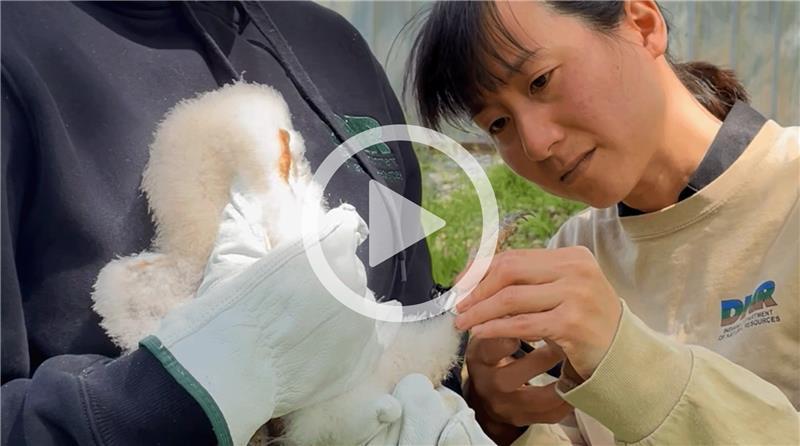
2024 boasts wildlife wins made possible by the Indiana Nongame Wildlife Fund
The Indiana Nongame Wildlife Fund has supported conservation initiatives for Indiana’s most vulnerable animal species since 1982. From improving ecosystem health to providing opportunities to see beautiful and unique animals across the state – having diverse wildlife populations improves our quality of life.
In 2024, DNR biologists improved Indiana’s Motus tower network, moved egg masses for the state endangered crawfish frog to re-establish the species at Angel Mounds State Historic Site, re-introduced Franklin’s ground squirrels to an area they previously inhabited at Kankakee Sands, and confirmed the reproduction of the elusive salamander mussel in a national wildlife refuge. See it for yourself in our new YouTube video.
This work and many other conservation efforts across Indiana was made possible largely thanks to donations to the Indiana Nongame Wildlife Fund. Follow along for updates on these and other projects by subscribing to the Nongame Wildlife Fund Newsletter and following the Division of Fish & Wildlife on Facebook and Instagram.
If you’re looking for a way to contribute to conservation during this season of giving, please consider donating to the Nongame Wildlife Fund. Thanks to federal match funding, for every $50 donated, Indiana receives an additional $93 for rare and endangered species conservation work.

A bio-engineered seawall installed on Dallas Lake in LaGrange County.
LARE applications due Jan. 15
A new year may mean a new conservation project for a body of water near you. Applications for submitting to the Lake and River Enhancement (LARE) program are due Jan. 15.
The LARE program strives to protect and enhance aquatic habitat for fish and wildlife while ensuring continued use of Indiana’s publicly accessible lakes, rivers, and streams. A full list of qualifying projects and application requirements is available on our website.
Recent news releases
Upcoming events
- Jan. 8 – Whooper Wednesday, Goose Pond FWA
- Jan. 18 – Project WET 'Climate, Water, and Resilience' Educator Workshop, Kokomo
- Jan. 23 – Project WET 'Climate, Water, and Resilience' Educator Workshop, Danville
- Jan. 24 – Project WET and Project WILD Climate Workshop, Richmond
More
- Buy a license
- Hunting information
- Where to Hunt
- Fishing information
- Where to Fish
- Fish & Wildlife properties

The Indiana Natural Resources Foundation celebrates and preserves Indiana’s natural legacy by raising funds to support the Indiana Department of Natural Resources (DNR) and its programs. Together, we have helped expand public lands, restore wildlife habitat, and create outdoor educational and recreational opportunities for Hoosiers.
About Fish and Wildlife Management in Indiana
Fish and wildlife management and public access are funded by fishing and hunting license revenue and also through the Wildlife and Sport Fish Restoration Programs administered by the U.S. Fish & Wildlife Service. These programs collect excise taxes on sporting arms and ammunition, archery equipment, fishing equipment, and motor boat fuels. The money is distributed among state fish and wildlife agencies based on land size and the number of licensed anglers and hunters in each state. Find out more information about fish and wildlife management in Indiana at Wildlife.IN.gov.
